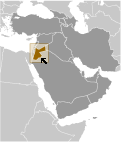World Atlas: Jordan. On this page you can see the map, country flag and many detailed information about the people, history and economy of Jordan.

Here you can find online selected information about the geography, inhabitants, government, economy and history of Jordan. Included are selected statistics, an overview map and the detailed map of Jordan. But let's start with the flag of Jordan here:
Jordan - Overview:
What you should know about Jordan? Let's start with this: Following World War I and the dissolution of the Ottoman Empire, the League of Nations awarded Britain the mandate to govern much of the Middle East. Britain demarcated a semi-autonomous region of Transjordan from Palestine in the early 1920s. The area gained its independence in 1946 and thereafter became The Hashemite Kingdom of Jordan. The country's long-time ruler, King Hussein (1953-99), successfully navigated competing pressures from the major powers (US, USSR, and UK), various Arab states, Israel, and a large internal Palestinian population. Jordan lost the West Bank to Israel in the 1967 Six-Day War. King Hussein in 1988 permanently relinquished Jordanian claims to the West Bank; in 1994 he signed a peace treaty with Israel. King Abdallah II, King Hussein's eldest son, assumed the throne following his father's death in 1999. He has implemented modest political and economic reforms, including the passage of a new electoral law in early 2016 ahead of legislative elections held in September. The Islamic Action Front, which is the political arm of the Jordanian Muslim Brotherhood, returned to parliament with 15 seats after boycotting the previous two elections in 2010 and 2013.
Geography of Jordan
 Where on the globe is Jordan? The location of this country is Middle East, northwest of Saudi Arabia, between Israel (to the west) and Iraq. Total area of Jordan is 89,342 sq km, of which 88,802 sq km is land. So this is not a large country. How could we describe the terrain of the country? This way: mostly desert plateau in east, highland area in west; Great Rift Valley separates eastern and western banks of the Jordan Rive. The lowest point of Jordan is Dead Sea -431 m, the highest point Jabal Umm ad Dami 1,854 m. And the climate is mostly arid desert; rainy season in west (November to April).
Where on the globe is Jordan? The location of this country is Middle East, northwest of Saudi Arabia, between Israel (to the west) and Iraq. Total area of Jordan is 89,342 sq km, of which 88,802 sq km is land. So this is not a large country. How could we describe the terrain of the country? This way: mostly desert plateau in east, highland area in west; Great Rift Valley separates eastern and western banks of the Jordan Rive. The lowest point of Jordan is Dead Sea -431 m, the highest point Jabal Umm ad Dami 1,854 m. And the climate is mostly arid desert; rainy season in west (November to April).
Inhabitants of Jordan
Let's take a look how many people live in Jordan. The number is: 10,248,069. So this is not very populous country. Who lives here? Arab 98%, Circassian 1%, Armenian 1%. What are the languages in Jordan? Arabic (official), English (widely understood among upper and middle classes). And the religions: Muslim 97.2% (official; predominantly Sunni), Christian 2.2% (majority Greek Orthodox, but some Greek and Roman Catholics, Syrian Orthodox, Coptic Orthodox, Armenian Orthodox, and Protestant denominations), Buddhist 0.4%, Hindu 0.1%, Jewish . How old are the people in average? 22.5 years. We have to add that this number is the median - so one half of the people is older than this, one half is younger. And what is their life expectancy (at birth)? This: 74.8 years. Where the people live in Jordan? Here: population heavily concentrated in the west, and particularly the northwest, in and around the capital of Amman; a sizeable, but smaller population is located in the southwest along the shore of the Gulf of Aqaba. The major urban areas of Jordan are: Amman (capital) 1.155 million (2015).
Government and Economy of Jordan
The capital of Jordan is Amman and the government type parliamentary constitutional monarchy. Let's take a look at the administrative divisions - 12 governorates (muhafazat, singular - muhafazah); 'Ajlun, Al 'Aqabah, Al Balqa', Al Karak, Al Mafraq, Al ?Asimah (Amman), At Tafilah, Az Zarqa', Irbid, Jarash, Ma'an, Madaba. Regarding the economy of Jordan, important industrial products are tourism, information technology, clothing, fertilizer, potash, phosphate mining, pharmaceuticals, petroleum refining, cement, inorganic chemicals, light manufacturing. Important agricultural products are citrus, tomatoes, cucumbers, olives, strawberries, stone fruits; sheep, poultry, dairy. The most important export commodities are textiles, fertilizers, potash, phosphates, vegetables, pharmaceuticals and the most important export partners are US 25.2%, Saudi Arabia 14.2%, India 8.4%, Iraq 6.8%, UAE 5.6%, Kuwait 5.1% (2016). The most important import commodities are crude oil, refined petroleum products, machinery, transport equipment, iron, cereals and the most important import partners are China 14%, Saudi Arabia 11.8%, US 7.4%, Germany 4.8%, Italy 4.7%, UAE 4.4% (2016). How rich is Jordan and how rich are people in this country? The most important number here is GDP per capita (PPP): $12,500 (2017 est.). This is quite good. Let's add that this means Gross Domestic Product per person, which is recalculated with respect to the relative cost of local goods and services. And one more important number - population below poverty line: 14.2% (2002 est.).